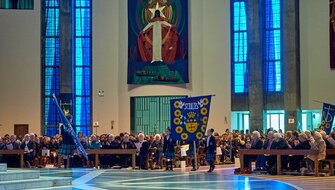
It’s fifty years since Julie was declared a saint by Pope Paul VI and life has changed quite drastically since then. In 1969 the Catholic Church was experiencing a sense of renewal and optimism in the light of the Second Vatican Council. Vocations to the religious life and priesthood seemed plentiful and seminaries and convents were built to accommodate the influx. When I joined the Sisters of Notre Dame 21 women joined with me. It was as though the Church was on a roll. Now fifty years later there’s some dispute about the legacy of the Vatican Council. Some people are remembering pre-Vatican II days with nostalgia and want to recapture some of that while others are impatient that the expected changes in the Church haven’t materialised as they hoped. Congregations within Churches have declined drastically – at least in Europe- and young people are not joining religious congregations as they did in the past. And those of us who did stay are getting older. There’s not a sense of decline exactly but a questioning of the future and our lasting impact on those we have worked with over the years.
This question was party answered at the celebration of the canonisation of Julie which in Britain took place in Liverpool Cathedral. It was attended by pupils from the Secondary Schools in the country that had previously been run by Sisters of Notre Dame. Pupils came from Scotland and London as well as areas around Liverpool. I couldn’t be there but all the reports, photographs, videos show a celebration of light, joy, energy and life. 1500 young people with all the life and energy of youth were witnessing to the continuing effect of the work of Julie and the religious community she founded. It was a moment of pride but also one of gratitude for a legacy that has been handed on, is greater than any of us and will continue in the life and work of the staff and students in the schools touched by Julie’s life and spirit. We need not be afraid of the future. Even if we die out in this country there is a legacy that will live on and this gives us hope.
My contribution to the celebrations was to help write a novena – a nine day series of reflections on the life of Julie to help people reflect on her life and relevance today. It was surprising how many parallels there were between her time and ours. She was born in 1751 in Cuvilly and grew up in this quiet rural village where life was regulated by the seasons and the community close knit. No doubt the rumblings of revolution were in the air but whether they reached Cuvilly or not isn’t known. The year 1789 saw violence erupt with the storming of the Bastille and the overthrow of the French monarchy under the banner of Fraternity, Liberty, Equality. Heavy taxation and a failed harvest had meant many people living in dire poverty and resentment grew against the aristocracy and the clergy of the Established Catholic Church who enjoyed a wealth and privilege closed to the majority of the population. Julie was caught up in this social turmoil and political upheaval. She was hounded by the revolutionaries because of her commitment to her faith and to a Church that had been suppressed. She knew what it was to be a refugee and to move from place to place for her safety, eventually having to move from her homeland to Belgium – not because of the French Revolution but because Julie had formed a community around her, committed to responding to the needs of the times and prepared to go wherever it was needed. This was a different kind of religious life from the past when sisters stayed in their convents and were under the jurisdiction of a priest. It was too much of a novelty for some clergy. One priest in particular wanted to control this new community and restrict its work to the city of Amiens.
So in 1807 the small congregation of Notre Dame found a home in Namur, Belgium. This was a different kind of society from that of France. Belgium was the first country in continental Europe to experience the Industrial Revolution. With its multiple rivers Belgium was ideal as a highway for goods and transportation and contributed to a worldwide economic revolution that led to the creation of the modern world. This was accompanied by the growth of urbanisation with ensuing ills such overcrowding, poor sanitation, disease, low pay, terrible working conditions and child labour. Julie and her community responded to the situation, setting up schools and institutions for girls and women to give them the skills to help them earn a living.
And then there were the Napoleonic Wars………
The life and times of Julie Billiart were not too dissimilar to our own. They were full of turmoil, insecurity, violence, poverty. Today we live in an uncertain world and Julie's congregation continues to listen to the signs of the times and respond appropriately throughout the world. But for us in Britain we take special pride in all those schools and young people who try to live out her charism, her special gift which is to believe in the goodness of God, often in the face of evidence to the contrary. They are keeping alive her spirit and they give us hope.


 RSS Feed
RSS Feed
